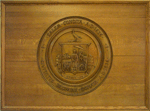City Orphan Asylum: Difference between revisions
mNo edit summary |
No edit summary |
||
| (3 intermediate revisions by 2 users not shown) | |||
| Line 12: | Line 12: | ||
Vertical File in Salem Collection - '''Orphan Asylum''' | Vertical File in Salem Collection - '''Orphan Asylum''' | ||
[http:// | [http://salem.noblenet.org/Record/1958881 Salem Women's Heritage Trail] by Bonnie Hurd Smith,p. 55 | ||
"Children in City Orphanage saved" ''Boston Globe'', June 26, 1914 p. 8 | "Children in City Orphanage saved" ''Boston Globe'', June 26, 1914 p. 8 | ||
Latest revision as of 13:32, 9 October 2025
The City Orphan Asylum was actually established by Thomas Looby, a private citizen. In 1866, Looby bought a building for an orphanage at the intersection of Washington and Bridge Streets. The home was staffed by the nuns from the Sisters of Charity. They were incoporated in 1871, under the name of City Orphan Asylum.
To meet the growing demand for more beds, a larger brick building was built at 215 Lafayette St. in 1863. By 1914, more than 100 children and a small number of indigent elderly woman lived there. The home was burned down in the great Salem Fire of 1914. After escaping the fire, all the children and 60 nuns were brought to live temporarily at St. John's Preparatory School in Danvers.
Later, they were transferred to the Home for Destitute Children in Boston.
See Also
Vertical File in Salem Collection - Orphan Asylum
Salem Women's Heritage Trail by Bonnie Hurd Smith,p. 55
"Children in City Orphanage saved" Boston Globe, June 26, 1914 p. 8
"Orphans removed from home in the nick of time" Salem Evening News, June 26, 1914, p.6
"City orphans sent to Boston" Salem Evening News, June 29, 1914, p.11
